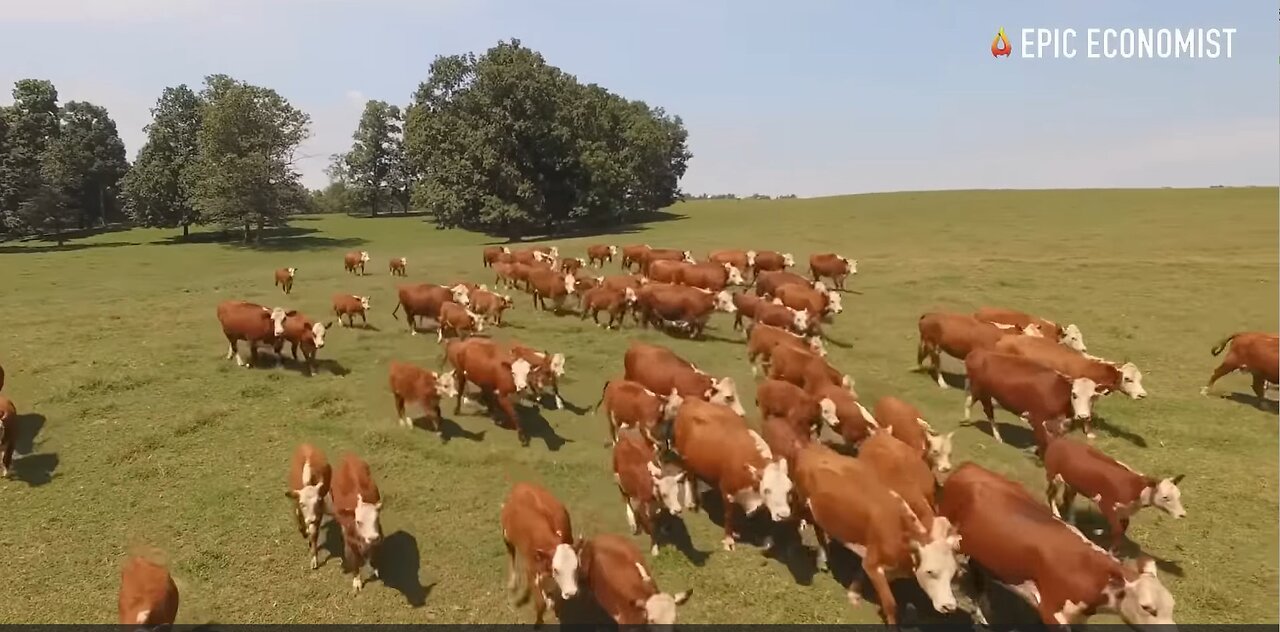Premium Only Content

BEEF PRICES expected to DOUBLE this Winter – Ranchers Warn due to Lowest Supply in Decades
Ranchers would rather sell than save their cattle for breeding as prices for beef skyrockets. This is leading to low supplies that have not been seen since the 70’s and 80’s. Hay prices are skyrocketing due to low supplies due to droughts throughout the country.
It’s great to be a rancher at the moment and not so great to be a consumer. Supplies expected to be very low into the unforeseen future.
Being a carnivore has never been so expensive. According to the USDA, beef prices soared to another record high this week, and are expected to face a 100% increase next month compared to the same period a year ago. Steaks will likely be out of the dinner table of many Americans in the coming months as shortages already started leaving grocery shelves empty.
Even cheap meats like ground beef are about to shoot up in price due to the lowest supply in decades, the Department said. The nation’s shrinking cattle herd combined with surging input costs at U.S. farms and ranches have pushed wholesale meat costs to over $8 per pound, official data shows.
Analysts predict that the figure could jump above the $ 10 mark in December due to the seasonal spike in demand. As a comparison, beef costs in 2022 were hoovering around the ten-year average of $5 per pound. The rapid price appreciation means that you will have to pay double what you paid a year ago to bring your favorite cut home this winter. In fact, meat inflation at U.S. stores can be even higher given that the USDA forecast was for wholesale prices, not consumer prices.
Adding rising labor and transportation costs to the mix, a pound of ground beef could be selling for $8.99 next month. A pound of sirloin is expected to reach $14.00, while T-bone, and ribeye, can reach $15.39 and $21.99 per pound, respectively.
“Relative to other proteins, beef prices are likely to stay elevated for the next couple of years due to tighter supplies,” according to Wells Fargo Agri-Food Institute sector manager Courtney Schmidt. “All consumers will be paying more for all beef products for several more years,” added Wells Fargo’s Chief Agricultural Economist Michael Swanson.
Retailers are already reporting leaner deliveries and falling meat supplies at stores. Ranchers, who would normally thrive on record prices, are instead struggling to maintain their business. Low rainfall in prime cattle-raising land is turning green pastures into dust fields. Limited supply and increasing costs are likely to cause changes in food service menu items.
“The prices of menu items may go up, including burger patties, as businesses try to maintain their profit margins,” Wells Fargo’s Swanson said. Fast food chains, including McDonald’s, Burger King, and Shake Shack, are some of the biggest buyers of meat in the U.S. market.
In 2024, they might have to conduct another round of price hikes to offset the rising cost of beef. These companies are also being encouraged to launch more plant-based alternatives to reduce their environmental footprint amid climate change. In other words, we will have to get used to eating meat alternatives instead of the real thing.
Beef is becoming a delicacy reserved only for the bourgeoisie. For now, this crisis will continue to add pressure on ranchers, restaurateurs, and average consumers. Until cattle numbers grow, input costs decline, and the economic storm abates, Americans will be forced to either change their diets or pay the price.
Video Mirrored from: Epic Economist -- https://www.youtube.com/watch?v=9mV36_Fqlkc
-
 6:33
6:33
Waking the World up
2 days ago“Hot Lots” – Deadly Batches PROVE that this was Intentional – “1 out of 200 Were Deadly”
3.02K6 -
 1:43:17
1:43:17
Benny Johnson
2 hours agoBREAKING: Mexico SURRENDERS To Trump, Locks Down Border | Mass FBI Firings, Deep State PURGE in DC
30.1K61 -
 LIVE
LIVE
Grant Stinchfield
1 hour agoTrump's Tariffs are Already Working... Here's Why...
405 watching -
 2:02:48
2:02:48
LFA TV
23 hours agoTARIFF TRADE WAR! | LIVE FROM AMERICA 2.3.25 11am
29.7K13 -
 LIVE
LIVE
The Dana Show with Dana Loesch
1 hour agoTRUMP IMPOSES TARIFFS ON IMPORTS FROM CANADA, CHINA & MEXICO | The Dana Show LIVE On Rumble!
560 watching -
 LIVE
LIVE
Major League Fishing
5 days agoLIVE! - Bass Pro Tour: Stage 1 - Day 4
244 watching -
 59:38
59:38
The Dan Bongino Show
5 hours agoTrump Is Setting The Old World Order Ablaze (Ep. 2414) - 02/03/2025
506K686 -
 1:02:10
1:02:10
The Rubin Report
2 hours agoJD Vance Makes Host Go Quiet with This Brutal Warning for These Major Countries
64.6K51 -
 2:00:51
2:00:51
Steven Crowder
4 hours agoWhy Trump & America Will Dominate the Global Trade War
347K193 -
 1:06:15
1:06:15
vivafrei
16 hours agoLive with "Bitcoin Jesus" Roger Ver - the Indictment, Law-Fare and the War on Crypto
84.4K8